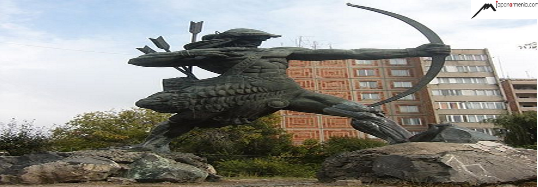
Haik Patriarch
Hayk the Great (Armenian: Հայկ), Armenian pronunciation: [hajk], or The Great Hayk, also known as Hayk Nahapet (ՀայկՆահապետ, Armenian pronunciation: [hajk nahapɛt], Hayk the “head of family” or patriarch), is the legendary patriarch and founder of the Armenian nation. His story is told in the History of Armenia attributed to the Armenian historian Moses of Chorene (410 to 490).
Contents
• 1Etymology
• 2Genealogy
• 3Folklore
•3.1Hayk and King Bel
•3.2Battle of Giants and defeat of Bel
Etymology
The name of the patriarch, Հայկ Hayk is not exactly homophonous with the name for “Armenia”, Հայք Hayk’. Հայք Hayk’ is the nominative plural in Classical Armenian of հայ(hay), the Armenian term for “Armenian.” Some claim that the etymology of Hayk’ (Հայք) from Hayk (Հայկ) is impossible and that the origin of the term Hay (“Armenian”) is verifiable. Nevertheless, Hayk and Haig are usually connected to hay (հայ) and hayer (հայեր, the nominative plural in Modern Armenian), the self-designation of the Armenians. Armen Petroyan believes that the name Hayk can “very plausibly” be derived from the Indo-European *poti- ‘master, lord, master of the house, husband’.
Hayk would then be an etiological founding figure, like e.g. Asshur for the Assyrians, etc. One of Hayk’s most famous scions, Aram, settled in Eastern Armenia from the Mitanni kingdom (Western Armenia), when Sargon II mentions a king of part of Armenia who bore the (Armenian-Indo-Iranian) name Bagatadi (“Theodore”).
Armenian historiography of the Soviet era connected Hayk with Hayasa, mentioned in Hittite inscriptions.
The Armenian word haykakan or haigagan (Armenian: հայկական, meaning “that which pertains to Armenians”) finds its stem in this progenitor.
Genealogy
Moses of Chorene gave Hayk’s genealogy as Japhet, Gomer and Tiras, Torgom. Hayk’s descendants are given as Amasya, Ara, Aram, Aramais, Armanak, Gegham, and Harma. Hayk was also said to be the founder of the Haykazuni Dynasty. Some of the prominent Armenian royal houses such as the Arran, Bagratuni, Bznuni, Khorkhoruni, Manavazian, Syuni, and Vahevuni trace their genealogy to Hayk Nahapet. According to Juansher, Hayk “was prince of the seven brothers and stood in service to the giant Nimrod (Nebrovt’) who first ruled the entire world as king.”
Folklore
Hayk and King Bel
“Hayk” by Mkrtum Hovnatanian (1779–1846). The legendary founder of the Armenian nation, standing next to the tomb of Bel, with Hayk’s arrow still in Bel’s chest. The map depicts the Lake Van region and Mount Ararat, with Noah’s ark.
In Moses of Chorene’s account, Hayk son of Torgom had a child named Armanak while he was living in Babylon. After the arrogant Titanid Bel made himself king over all, Hayk emigrated to the region near Mount Ararat. Hayk relocated near Mount Ararat with an extended household of at least 300 and settled there, founding a village he named Haykashen. On the way he had left a detachment in another settlement with his grandson Kadmos. Bel sent one of his sons to entreat him to return, but was refused. Bel decided to march against him with a massive force, but Hayk was warned ahead of time by Kadmos of his pending approach. He assembled his own army along the shore of Lake Van and told them that they must defeat and kill Bel, or die trying to do so, rather than become his slaves. In his writings Moses states that:
| “ | Hayk was a handsome, friendly man, with curly hair, sparkling eyes, and strong arms. He was a man of giant stature, a mighty archer and fearless warrior. Hayk and his people, from the time of their forefathers Noah and Japheth, had migrated south toward the warmer lands near Babylon. In that land there ruled a wicked giant, Bel. Bel tried to impose his tyranny upon Hayk’s people. But proud Hayk refused to submit to Bel. As soon as his son Aramaniak was born, Hayk rose up and led his people northward into the land of Ararad. At the foot of the mountain he built a village and gave it his name, calling Haykashen. | ” |
Battle of Giants and defeat of Bel
Hayk defeats Bel with an arrow.
Hayk and his men soon discovered Bel’s army positioned in a mountain pass (Moses of Chorene located the site as Dastakert), with the king in the vanguard.
At Dyutsaznamart (Armenian: Դյուցազնամարտ, “Battle of Giants”), near Julamerk southeast of Lake Van, on August 11, 2492 BC (according to the Armenian traditional chronology of Navasard) or 2107 BC (according to “The Chronological table” of Mikael Chamchian), Hayk slew Bel with a nearly impossible shot using a long bow, sending the king’s forces into disarray.
The hill where Bel with his warriors fell, Hayk named Gerezmank meaning “tombs”. He embalmed the corpse of Bel and ordered it to be taken to Hark where it was to be buried in a high place in the view of the wives and sons of the king.
Soon after, Hayk established the fortress of Haykaberd at the battle site and the town of Haykashen in the Armenian province of Taron(modern-day Turkey). He named the region of the battle Hayk, and the site of the battle Hayots Dzor.
the material is taken from https://en.wikipedia.org/wiki/Hayk










